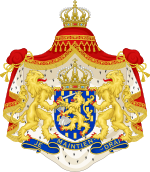- Third Drees cabinet
-
Netherlands 
This article is part of the series:
Politics and government of
the NetherlandsConstitutionCabinetDecentralized gov'tForeign policyRelated subjects
Drees III (13 October 1956 - 22 December 1958), was the fourth Dutch cabinet under prime minister Willem Drees, with ministers from PvdA, KVP, ARP end CHU.
The cabinet formation had taken 4 months. This was the longest and most difficult formation the Netherlands had ever seen, partly as a result of the rising tensions between PvdA and KVP. Also after the formation, these tensions kept rising, leading to the fall of the cabinet in December 1958. Root of the tensions were the decision of the Roman Catholic Church to excommunicate catholic socialists from the church. Nearly 100% of the south of the Netherlands used to vote for the catholic KVP for decades, but in the 1950s secular political parties got an increase in votes. The excommunication had the result of social exclusion in cities and villages which used to be solidly catholic blocks. Protestants in the north supported the Catholics.
After considerable growth after World War II, the rising wages,combined with lowered taxes, now led to overspending, which endangered the export. In reaction, wages and government spending were both lowered.
Rising tension with Indonesia, mostly about New Guinea, came to a climax when Indonesia nationalised Dutch properties in the country. The Dutch were supposed to leave entirely.
Other international problems were the Suez Crisis and the Hungarian revolt, which led to monetary and economic problems. The threat of an oil crisis as a result of the Suez crisis led to the installation of car-free Sundays. The suppression of the Hungarian revolution by the USSR led to plundering of communist institutions. Several thousands of Hungarian refugees were accepted into the Netherlands and welcomed in Dutch homes.
On 1 January 1957, the state pension AOW after the age of 65, that was proposed during the former cabinet Drees II, was installed. This resulted from a previous emergency law by Drees, and is the one thing he is remembered for most.
Source
- (Dutch) Kabinet-Drees III, Rijksoverheid.nl
Structure and process StructureGovernmentMinisters, including Ministers without Portfolio, chaired by the Prime Minister of the Netherlands and one or more Deputy Prime Minister of the NetherlandsProcessCurrent ministries Cabinets Schimmelpenninck • De Kempenaer-Donker Curtius • Thorbecke I • Van Hall-Donker Curtius • Van der Brugghen • Rochussen • Van Hall-Van Heemstra • Van Zuylen van Nijevelt-Van Heemstra •Thorbecke II • Fransen van de Putte •Van Zuylen van Nijevelt • Van Bosse-Fock • Thorbecke III • De Vries-Fransen van de Putte • Heemskerk-Van Lynden van Sandenburg • Kappeyne van de Coppello • Van Lynden van Sandenburg • Heemskerk Azn. • Mackay • Van Tienhoven • Röell • Pierson • Kuyper • De Meester • Heemskerk • Cort van der Linden • Ruijs de Beerenbrouck I • Ruijs de Beerenbrouck II • Colijn I • De Geer I • Ruijs de Beerenbrouck III • Colijn II • Colijn III • Colijn IV • Colijn V • De Geer II • Gerbrandy I • Gerbrandy II • Gerbrandy III • Schermerhorn-Drees • Beel I • Drees-Van Schaik • Drees I • Drees II • Drees III • Beel II • De Quay • Marijnen • Cals • Zijlstra • De Jong • Biesheuvel I • Biesheuvel II • Den Uyl • Van Agt I • Van Agt II • Van Agt III • Lubbers I • Lubbers II • Lubbers III • Kok I • Kok II • Balkenende I • Balkenende II • Balkenende III • Balkenende IV • RutteCategories:- Cabinets of the Netherlands
Wikimedia Foundation. 2010.
